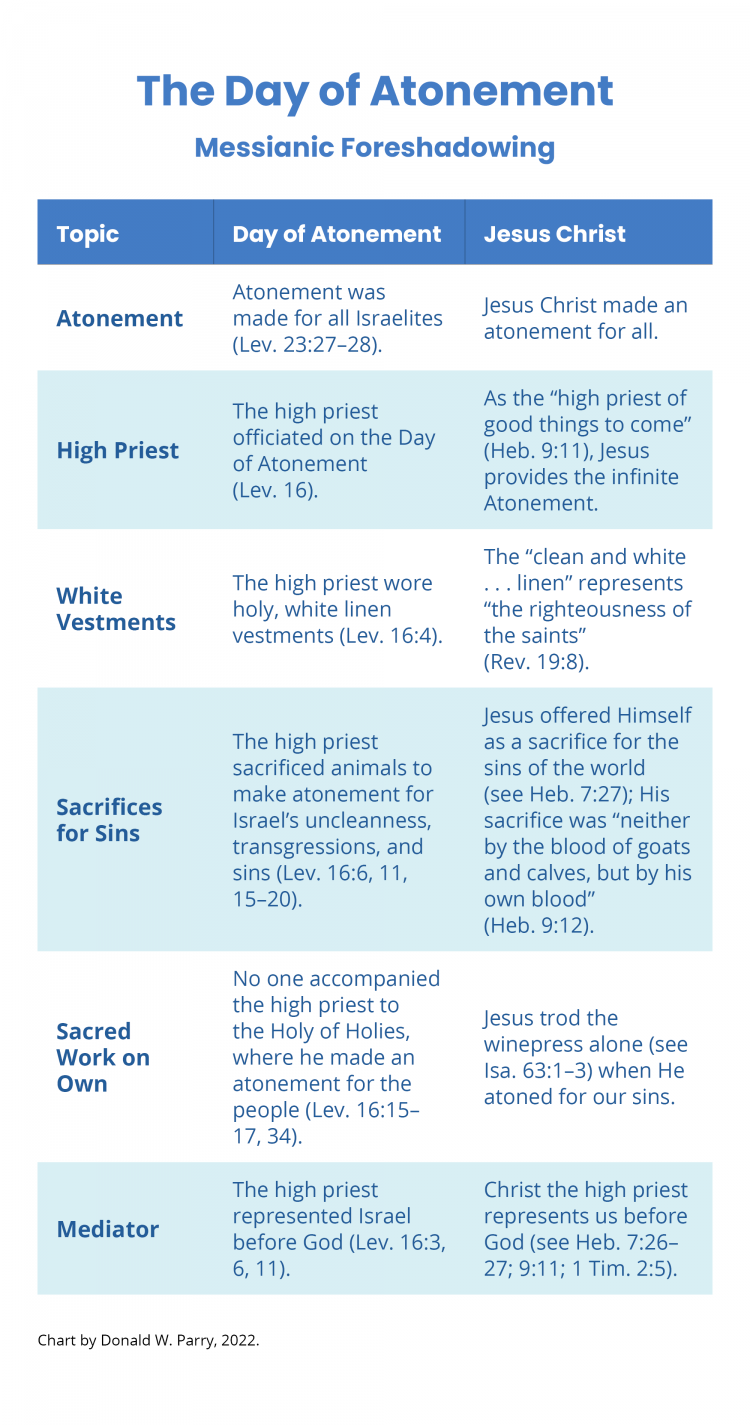You are here
The Day of Atonement: Messianic Foreshadowing
| Title | The Day of Atonement: Messianic Foreshadowing |
| Publication Type | Book Chapter |
| Year of Publication | 2022 |
| Authors | Parry, Donald W. |
| Book Title | The Jesus Christ Focused Old Testament: Making Sense of a Monumental Book |
| Pagination | 104-105 |
| Publisher | Book of Mormon Central |
| City | Springville, UT |
Show Full Text
The Day of Atonement, held the tenth day of the seventh month of the year, was an exceptionally hallowed ancient Israelite festival. It focused on a number of symbols and rituals that pertained to the Atonement, such as the sacrifice of a bull and a goat, the confession of sins on the head of a second goat (the scapegoat), the sprinkling of blood on the altar, and the high priest’s entrance into the temple’s Holy of Holies.
The directive regarding the scapegoat was straightforward: “And Aaron shall lay both his hands upon the head of the live goat, and confess over him all the iniquities of the children of Israel, and all their transgressions in all their sins, putting them upon the head of the goat. . . . And the goat shall bear upon him all their iniquities unto a land not inhabited” (Lev. 16:21–22). It was during the Day of Atonement that the high priest made atonement for the tabernacle and the altar, for the priests, and for the people: “And this shall be an everlasting statute unto you, to make an atonement for the children of Israel for all their sins once a year” (Lev. 16:34).
|
Topic |
Day of Atonement |
Jesus Christ |
|---|---|---|
|
Atonement |
Atonement was made for all Israelites (Lev. 23:27–28). |
Jesus Christ made an atonement for all. |
|
High Priest |
The high priest officiated on the Day of Atonement (Lev. 16). |
As the “high priest of good things to come” (Heb. 9:11), Jesus provides the infinite Atonement. |
|
White Vestments |
The high priest wore holy, white linen vestments (Lev. 16:4). |
The “clean and white . . . linen” represents “the righteousness of the saints” (Rev. 19:8). |
|
Sacrifices for Sins |
The high priest sacrificed animals to make atonement for Israel’s uncleanness, transgressions, and sins (Lev. 16:6, 11, 15–20). |
Jesus offered Himself as a sacrifice for the sins of the world (see Heb. 7:27); His sacrifice was “neither by the blood of goats and calves, but by his own blood” (Heb. 9:12). |
|
Sacred Work on Own |
No one accompanied the high priest to the Holy of Holies, where he made an atonement for the people (Lev. 16:15–17, 34). |
Jesus trod the winepress alone (see Isa. 63:1–3) when He atoned for our sins. |
|
Mediator |
The high priest represented Israel before God (Lev. 16:3, 6, 11). |
Christ the high priest represents us before God (see Heb. 7:26–27; 9:11; 1 Tim. 2:5). |
Terms of Use
Items in the BMC Archive are made publicly available for non-commercial, private use. Inclusion within the BMC Archive does not imply endorsement. Items do not represent the official views of The Church of Jesus Christ of Latter-day Saints or of Book of Mormon Central.
Bibliographic Citation
Subscribe
Get the latest updates on Book of Mormon topics and research for free

